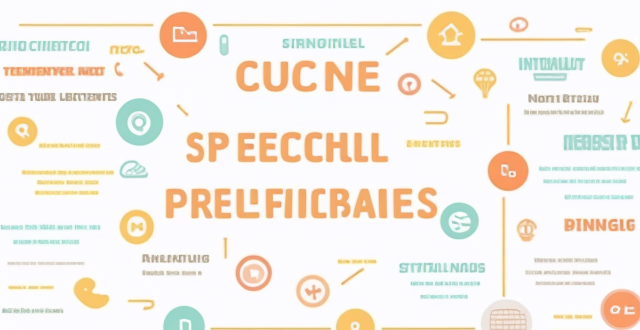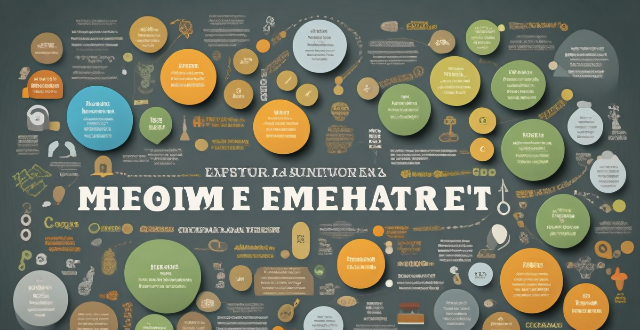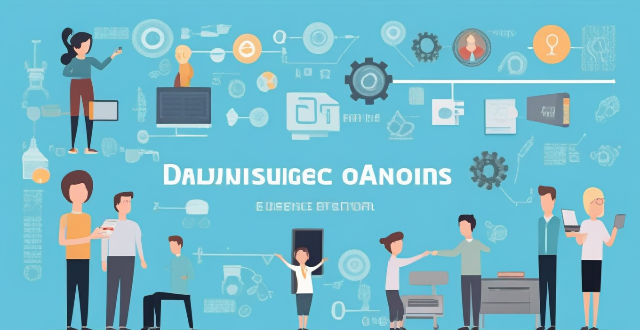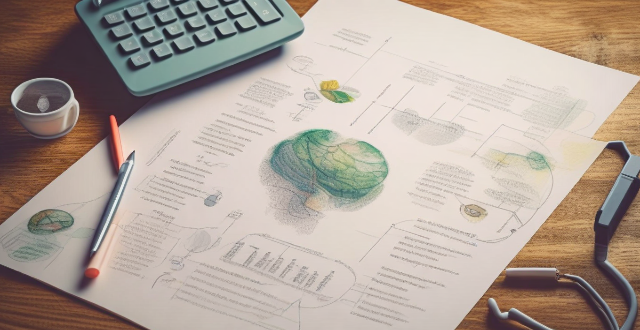Progress Review

How often should I review my study plan to ensure its effectiveness ?
To ensure the effectiveness of your study plan, it's crucial to review it regularly. Weekly reviews help assess progress, adjust timelines, identify challenges, celebrate successes, and make necessary changes. Monthly reviews involve evaluating overall goals, reflecting on learning style, considering external factors, setting new goals, and updating the plan. Quarterly reviews analyze long-term progress, revisit motivation, assess habits and routines, seek feedback, and create a new plan. Being flexible and open to making changes is key.

How can we measure progress towards achieving the Sustainable Development Goals ?
The text discusses the importance of measuring progress towards achieving the Sustainable Development Goals (SDGs) set by the United Nations in 2015. It outlines seven key steps to effectively monitor and evaluate this progress: establishing baseline data, tracking specific indicators, reporting and reviewing progress, utilizing technology, engaging stakeholders, addressing data gaps, and ensuring transparency and accountability. Each step includes a detailed explanation of methods and strategies to implement it successfully. The goal is to provide a structured approach for countries and organizations to assess their performance in meeting the ambitious objectives aimed at tackling global challenges such as poverty, inequality, and environmental degradation.

How do you measure progress in students with special education needs ?
Measuring progress in students with special education needs (SEN) is crucial for understanding the effectiveness of interventions and ensuring appropriate education. Identify goals through Individualized Education Plans and focus on functional skills. Use formative assessments, standardized testing, and alternative assessments to monitor progress. Implement progress monitoring tools and analyze data to inform instructional decisions. Ensure accommodations and modifications are effective and regularly updated. Maintain open communication with parents and collaborate with a team to support the student's development.

What makes a product review credible and trustworthy ?
Product reviews play a crucial role in purchasing decisions by offering insights into performance, quality, and satisfaction. Not all reviews are equal; some are more credible and trustworthy. A credible review is detailed, unbiased, authentic, timely, visually supported, comparative, from a verified purchaser, and free from ulterior motives. Looking for these elements in reviews helps consumers make informed decisions.

How often should I review and adjust my budget ?
Regular budget reviews are essential for maintaining financial health, helping to align spending with evolving goals, adjust for unexpected expenses, and account for inflation. Conduct monthly, quarterly, and annual reviews to monitor cash flow, analyze spending patterns, and make necessary adjustments. Focus on income vs. expenses, debt management, savings goals, emergency funds, subscription services, and bill negotiation. After each review, adjust spending, increase savings, revisit goals, improve cash flow, and seek professional advice as needed.

How do I rate and review apps on the App Store ?
Rating and reviewing apps on the App Store is crucial for developers and users. Here's how to do it: open the App Store, find the app, tap on it, go to the Reviews tab, write your review, rate the app, and submit your feedback. This helps improve apps and informs other users.

How often should a business review its credit management policies ?
The frequency of reviewing your credit management policies will depend on various factors specific to your business. However, by conducting regular reviews and staying vigilant about potential issues, you can help ensure that your policies remain effective and aligned with your business goals.

Are there any independent review sites that rate online shopping platforms ?
This article discusses the importance of independent review sites in evaluating online shopping platforms. It explains what independent review sites are, the benefits of using them, and provides examples of such sites. The article concludes that these sites play a crucial role in helping consumers make informed decisions about which online shopping platforms to use by providing unbiased information and comparative analysis.

How often should I review and adjust my tax planning strategy ?
Tax planning is an ongoing process that requires regular review and adjustment to ensure that you are taking advantage of all available tax breaks and staying in compliance with the law. Here are some factors to consider when determining how often to review and adjust your tax planning strategy: - Major life changes such as marriage, divorce, having a child, buying or selling a home, starting or closing a business, or retirement should prompt a review of your tax planning strategy. - Changes in tax laws can significantly impact your tax liability, so it's important to stay up-to-date on any changes and review your strategy accordingly. - Even if nothing significant has changed in your life or the tax laws, it's a good idea to review your tax planning strategy at least once a year. - For businesses or individuals with complex tax situations, quarterly reviews may be beneficial to stay on top of any changes in income or expenses and make adjustments throughout the year to minimize tax liability.

How often should I review and update my estate plan ?
Estate planning is crucial for managing assets post-demise. It requires regular updates due to life changes, laws, and preferences. Major life events necessitate immediate attention. Annual reviews ensure documents are current and reflect personal relationship changes. Every three to five years, review to accommodate tax law changes and reassess beneficiaries. Law changes may also prompt updates. Regular reviews ensure your estate plan aligns with life's dynamics.

What role does social media play in product review dissemination ?
The article discusses the significant role of social media in product review dissemination. It highlights the concept of "social proof" where people trust and adopt a product seeing others using it and sharing positive reviews. Social media platforms provide a platform for users to share their experiences with products, both good and bad, which can greatly influence potential customers' purchasing decisions. User-generated content (UGC) is a powerful tool for brands looking to promote their products. By encouraging customers to share their experiences with a product on social media, brands can leverage the power of social proof to attract new customers. Influencer marketing is another way that social media affects product review dissemination. Brands partner with influencers who have large followings on social media platforms to promote their products. Online reviews have become an essential part of the purchasing process for many consumers. Social media platforms provide a space for users to share their thoughts and opinions about products, allowing potential customers to make informed decisions before making a purchase. The trustworthiness, variety of opinions, and timeliness of online reviews greatly impact a consumer's decision to purchase a product or not. In conclusion, social media plays a crucial role in product review dissemination by providing a platform for users to share their experiences with products, promoting user-generated content and influencer marketing, and facilitating the sharing of online reviews.

What is the best way to review and revise my notes before an exam ?
The best way to review and revise notes before an exam involves organizing your notes, using active learning techniques such as self-testing and teaching others, employing spaced repetition for better retention, mixing up study methods, maintaining good health through sleep and nutrition, and conducting a final review closer to the exam date. Consistent and continuous study habits are crucial for success.

How often should I review and update my insurance coverage ?
Insurance coverage is a vital part of financial planning, and it's essential to ensure that policies are up-to-date and reflect current needs. Here's a guide on how often to review and update insurance coverage: 1. **Life Events**: Review coverage during significant life events like marriage, divorce, having children, buying a home, retirement, or job changes. 2. **Annual Check-ups**: Even without major life events, annual reviews help ensure coverage sufficiency, competitive rates, and accurate policy details. 3. **Quarterly Check-ins**: These can aid in monitoring premium payments and understanding policy updates or regulatory changes. 4. **Monthly Reminders**: Set reminders to monitor claims processing, check for discounts, and update emergency contact information. By staying proactive and informed about insurance policies, individuals can ensure they have the right coverage for their evolving needs.

How often should I review and update my knowledge framework to ensure it remains relevant and accurate ?
To ensure your knowledge framework remains relevant and accurate, review and update it regularly. The frequency depends on factors like the rate of change in your field, learning goals, and the amount of new information encountered. General guidelines include weekly reviews, monthly updates, quarterly assessments, and annual overhauls. Tips for effective review and update include setting aside dedicated time, being open to change, using organizational tools, and seeking feedback.

How do I measure progress in my sports training plan ?
Measuring progress is crucial for athletes to track development and adjust their training plans. Set SMART goals, track performance, evaluate technique, monitor body composition, assess fitness level, and reflect on mental state to measure progress effectively.

What methods can be used to assess a child's progress in homeschooling ?
In recent years, homeschooling has become a popular option for parents who prefer to educate their children at home. However, assessing a child's progress in homeschooling can be challenging for both parents and educators. In this article, we will discuss some methods that can be used to evaluate a child's academic and personal growth in a homeschooling environment. Regular testing and evaluations are one of the most effective ways to assess a child's progress in homeschooling. This can include standardized tests, such as the Iowa Test of Basic Skills or the Stanford Achievement Test, which measure a child's knowledge and skills in various subject areas. Additionally, parents can create their own tests and quizzes based on the curriculum they are using. Another method for evaluating a child's progress in homeschooling is through portfolio assessment. This involves collecting samples of a child's work over time, such as writing assignments, science projects, art pieces, and other creative endeavors. By reviewing these samples, parents and educators can gain insight into a child's strengths, weaknesses, and overall development. Observing a child's daily activities and keeping a record of their progress through journaling can also be an effective way to assess their development in homeschooling. Parents can observe their child's behavior during lessons, note any challenges or successes, and track their progress over time. Finally, receiving feedback from others can provide valuable insights into a child's progress in homeschooling. This can include feedback from tutors, online teachers, or even family members who have observed the child's learning process. By gathering input from multiple sources, parents can gain a more comprehensive understanding of their child's academic and personal growth. In conclusion, assessing a child's progress in homeschooling requires a combination of methods, including regular testing and evaluations, portfolio assessment, observations and journaling, and feedback from others. By utilizing these strategies, parents and educators can gain a better understanding of a child's academic and personal growth and make informed decisions about their educational journey.

How can I track my progress if I'm only exercising at home ?
**Tracking Progress in Home Exercises** When working out at home, monitoring your progress helps you stay motivated and makes adjustments to your routine. Here are key strategies: 1. **Set Clear Goals:** Divide goals into short-term (e.g., increasing push-ups) and long-term (e.g., weight loss). Ensure they're specific and achievable. 2. **Keep a Workout Journal:** Record details of each session, reflect on what works, and make necessary changes. 3. **Use Technology:** Fitness apps and smart devices can track metrics like steps and heart rate. 4. **Take Measurements:** Regularly measure weight, body fat, and performance metrics to see physical changes. 5. **Evaluate Intensity and Recovery:** Use RPE to assess workout difficulty and monitor recovery times after exercise. 6. **Compare Against Baseline:** Regularly reassess initial measurements and performances to gauge improvement. 7. **Utilize Visual Cues:** Photos and mirror checks can show changes in your physique over time. 8. **Engage in Strength Training:** Track the weight lifted and rep maxes to indicate strength gains. 9. **Focus on Feel and Function:** Pay attention to how your body feels during workouts and improve the quality of movement. By employing these methods, you can effectively track your progress while exercising at home, ensuring consistent improvements and maintaining motivation.

How much time should I dedicate daily to achieve rapid progress in a foreign language ?
To achieve rapid progress in a foreign language, itTo achieve rapid progress in a foreign language, iticate a significant amount of time it is crucial to dedicate a significant amount of time daily to practice and study, including both active and passive learning activities. Establishing a daily study routine, setting realistic goals, and maintaining consistency are key strategies for success.

Are there any apps or tools that can help me track my progress in understanding different texts ?
The text discusses various apps and tools that can help users track their progress in understanding different texts, including Reading Comprehension Apps like Quizlet and Khan Academy; Productivity Tools for Text Comprehension such as Evernote and Trello; Online Tools for Text Analysis like SparkNotes and CliffsNotes; and Personalized Learning Platforms like Adaptive Learning Systems. These resources provide features such as flashcards, video tutorials, annotations, note-taking, project boards, database views, plot summaries, character analysis, chapter-by-chapter breakdowns, close reading, personalized pathways, real-time feedback, and reading logs to aid comprehension and monitor progress.

How has climate action evolved over the past decade, and what progress has been made ?
Over the past decade, significant strides have been made in the realm of climate action. This evolution is characterized by increased awareness, global mobilization, technological advancements, and policy changes aimed at mitigating the effects of climate change. Key aspects of this progress include: 1. **Increased Awareness and Global Mobilization**: Public awareness about climate change has grown substantially, thanks to educational initiatives, media campaigns, youth-led movements like Fridays for Future, and UNFCCC COP conferences. 2. **Technological Advancements**: Remarkable progress in renewable energy technologies, electric vehicles, energy efficiency, and carbon capture has been made. 3. **Policy Changes and Legal Frameworks**: Many countries have implemented policies to reduce greenhouse gas emissions and promote clean energy. The Paris Agreement set a global framework for combating climate change. 4. **Financial Investments and Market Mechanisms**: Green finance, carbon pricing, and investment in sustainable infrastructure are on the rise. 5. **Corporate Responsibility and Innovation**: Corporations are setting sustainability goals, managing their supply chains more sustainably, and consumers are choosing environmentally responsible products. 6. **Civil Society and Community Action**: Grassroots organizations lead community-based actions, local communities establish renewable projects, and NGOs advocate for stronger climate policies. 7. **Research and Collaboration**: Ongoing scientific research, international platforms, and open data initiatives foster collaboration and better understanding of climate solutions. 8. **Challenges and Setbacks**: Despite advancements, challenges remain, including political will, economic barriers, inequity, and loss and damage from climate change. In conclusion, while notable progress has been made in climate action over the past decade, continued efforts across all sectors will be required to meet ambitious goals and limit climate change impacts.

How often should I use a carbon footprint calculator to track my progress ?
The article discusses the importance of tracking one's carbon footprint and how a carbon footprint calculator can be used to measure progress in reducing it. It suggests starting with an initial assessment, then checking monthly for changes, quarterly reviews for trends, and annual reassessments to evaluate overall progress. Key areas to focus on include transportation, energy consumption, dietary choices, and waste management. Regular use of a carbon footprint calculator is essential for leading a more sustainable life.

How are international climate agreements enforced, and what are the consequences of non-compliance ?
Enforcement of international climate agreements is crucial for mitigating the effects of climate change. The enforcement relies on mechanisms such as monitoring and reporting, peer review, financial incentives, and consequences of non-compliance. Countries are required to report their greenhouse gas emissions and progress towards meeting their commitments, which are reviewed by other countries and experts. Peer review helps identify any issues or discrepancies in the reported data and promotes transparency and accountability. Financial incentives, such as access to funding for climate action projects, can encourage compliance. Non-compliance can have significant consequences, including loss of credibility, economic impacts, legal actions, loss of funding, and reputational damage. Enforcement mechanisms rely heavily on voluntary compliance and cooperation between nations.

What are some common mistakes people make when trying to save money ?
Saving money is a crucial aspect of financial planning, but it's not always easy. Many people struggle with saving money and often make some common mistakes that can hinder their progress. Here are some of the most frequent errors people commit when trying to save money: Not having a clear savings goal, underestimating expenses or overestimating income, impulse buying, not taking advantage of discounts and deals, not automating savings, spending on depreciating assets, not reviewing banking and service providers, and ignoring the power of compound interest. By avoiding these common pitfalls, individuals can make substantial progress in their savings journey and achieve their financial goals more efficiently.

What are some creative ways to make studying from notes more engaging ?
The article discusses various strategies to make note-based learning more engaging and effective. The suggested approaches include interactive notebooks, active review techniques, digital integration, engaging activities, and regular revision schedules. Interactive notebooks involve color coding, diagrams, and margin notes for visual appeal and memory retention. Active review techniques such as teach it back, flashcards, and summarization help in understanding and recalling concepts better. Digital integration tools like note-taking apps, Quizlet, and online collaboration platforms aid in organizing and sharing notes. Engaging activities like role-playing, debates, and gamification elements promote kinesthetic learning and discussions. Regular revision schedules with spaced repetition, review tracking, and reflection time ensure long-term memory retention. By incorporating these strategies, studying from notes becomes a dynamic and engaging process that enhances both understanding and retention of the material.

How often should safety signs be reviewed and updated in a facility ?
Safety signs should be reviewed annually and updated immediately when necessary to maintain a safe environment in a facility.

What challenges might I face when constructing a knowledge framework, and how can I overcome them ?
The text discusses the challenges in constructing a knowledge framework and provides solutions to these challenges. The challenges include identifying relevant information, structuring the framework, technical limitations, human factors, and maintenance and updates. The solutions suggested are using reliable sources, implementing filtering techniques, consulting with experts, using an iterative approach, visual mapping, modular design, custom development, flexible design, peer review, user testing, feedback loops, automated systems, dedicated teams, and regular reviews. By anticipating potential challenges and implementing appropriate solutions, you can create a robust and effective knowledge framework that supports learning, decision-making, and innovation within your domain.

What ethical considerations should be taken into account when writing product reviews ?
Ethical considerations are crucial when writing product reviews to ensure trustworthiness and credibility. Reviewers should be honest, transparent, fair, and impartial, respect intellectual property, and be responsible towards readers. They must disclose any personal or financial interests, provide accurate information, avoid biased opinions, and refrain from making personal attacks. Comparative analysis should be fair, and language neutral. Original content is essential, with proper credit given where due, and copyright compliance maintained. Trade secrets should not be revealed, and trademarks or patents should not be infringed upon. The review's purpose should be clear, useful information provided, potential issues warned about, old reviews updated, and feedback engaged with. By considering these aspects, reviewers can contribute positively to the online community and build trust with their audience.

How can companies improve their products based on customer reviews ?
Companies can improve their products by listening to customer reviews, addressing negative feedback, encouraging constructive criticism, implementing continuous improvement, and leveraging positive reviews. This involves analyzing feedback using NLP tools, categorizing issues, prioritizing actions, investigating complaints, implementing fixes, communicating changes, creating a supportive environment for honest feedback, establishing a feedback loop, iterating rapidly, monitoring progress, highlighting strengths, celebrating successes, and maintaining quality. By doing so, companies can enhance their offerings and stay relevant in the market.

Are there any specific techniques to boost understanding during lectures or presentations ?
Boosting Understanding During Lectures or Presentations Active listening techniques, visual aids, questioning strategies, participation and interaction, and review and reinforcement are all methods to improve understanding during lectures or presentations. Engaging with the material, taking selective notes, using diagrams and illustrations, asking questions, joining group discussions, and reviewing notes promptly can all help enhance comprehension and make it easier to retain and apply the information later on.

What strategies should I use to manage my time during exams ?
Managing time effectively during exams is crucial for success. Here are strategies to help you prepare, allocate time wisely, prioritize questions, maintain a steady pace, review your work, manage stress, and stay healthy: 1. **Preparation**: Understand the exam format, practice with past papers, and study in advance to reduce last-minute stress. 2. **Time Allocation**: Allocate time according to the marks of each question, read instructions carefully, and be realistic about the time spent on each question. 3. **Prioritization**: Answer easy questions first to build confidence and mark difficult ones for review later. 4. **Pacing**: Keep an eye on the clock and maintain a comfortable pace to ensure all questions are answered thoroughly. 5. **Review and Adjustment**: Leave time at the end to review answers and check for errors. 6. **Stress Management**: Stay calm using deep breaths and relaxation techniques to manage stress during the exam. 7. **Health and Hydration**: Stay hydrated and eat lightly to maintain energy levels. By following these strategies, you can maximize your efficiency and performance during exams.